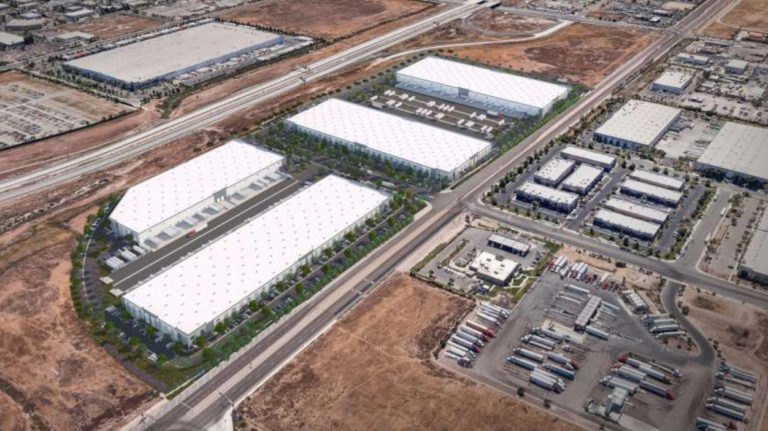The Landmark at Otay will be situated close to San Diego’s eastern U.S.-Mexico border crossing.
Construction has begun on a $100 million, 50-acre industrial park near San Diego’s eastern border crossing with Mexico.
The Landmark at Otay project is anticipated to take advantage of the rapid industrialization near the Otay Mesa Port of Entry, as well as infrastructure improvements near — and surrounding — the U.S.-Mexico border.
Businesses in Otay Mesa have been able to profit from substantial increased trucking imports from manufacturers in Baja California. For several years, many American manufacturers have been shifting outsourced manufacturing in Asia to Mexico, leading to rapid industrial growth near border crossings in San Diego and parts of Texas.
The project is a 50/50 joint venture from two Southern California companies, City of Industry-based Majestic Realty Co. and San Diego-based Sunroad Enterprises. It is their second project together, the first being the roughly $30 million Majestic Sunroad Center in Otay Mesa that is nearing completion and almost fully leased.
Tom Simmons, Majestic Realty Co. vice president, said his company intends to hold the Landmark at Otay project “forever” and was not trying to build something and sell it quickly. Majestic is also constructing facilities near the border in Texas.
“We find, and strategically invest, in markets because there is a story behind a market,” he said. “There is definitely a story behind Otay Mesa, (and that is something) that Majestic has some serious conviction about. That is why we have spent several years working on expanding our footprint.”
Landmark at Otay will have four buildings and will be one of the largest industrial parks in San Diego County’s history. Construction of the first two buildings, one with 216,140 square feet and another with 153,630 square feet, is expected to be completed by the end of 2021. Simmons said the construction timeline of the final two buildings — at 240,975 square feet and 235,085 square feet — will depend on market conditions and speed of approvals.
The facility will be located near the intersection of the 905 and 125 highways on land that was previously vacant. It is about one mile from the border off of La Media Road. The project began pouring concrete in January following the completion of grading and environment and tribal inspections.
Simmons said the project is at least $100 million, but the cost could go up because it is building it to spec — meaning it will configure the space based on who leases it — and that could bring additional costs. The buildings are planned to have ceilings higher than 30 feet, allowing for substantial storage.
Tenants are expected to be similar to those that have signed on to the joint ventures’ smaller project, Majestic Sunroad Center. Some of the renters include Vidal Corp., a cross-border logistics company, and R.L Jones Customhouse brokers, a customs broker.
Changes at the Otay Mesa crossing are happening quickly. Some of the biggest recent moves have been the conversion of California State Route 905 into a freeway and the creation of the Cross Border Xpress, or CBX, facility that allows for travelers out of Tijuana’s airport to easily cross to the United States.
The border crossing began a $137.2 million remodel in May that will expand its capacity from six lanes to 12 and makes other improvements to modernize. In December, state officials awarded $65 million for improvements at the Otay Mesa crossing. The project will include the widening of La Media Road, itself costing around $43 million, and work toward the construction and planning of a third border crossing.
Increased business in Otay Mesa led to the sale of 2020 Piper Ranch for $109 million in December by Denver based-Black Creek Group. The 601,417-square-foot building, one of the largest in San Diego County and biggest in Otay Mesa, was built in 2003 and is about 1.5 miles from the Otay Mesa Port of Entry. Unlike Landmark at Otay, it is spread out over one building, as opposed to four separate ones.
A shift to Mexico, away from Asia, for American companies began during the Trump administration’s U.S.-China trade war. Other factors have continued the trend: A slowdown in supply chains from Asian nations during the COVID-19 pandemic, as well as the United States–Mexico–Canada Agreement, or USMCA, signed (revised version) in late 2019. That agreement gives benefits to member nations to import from neighbors instead of overseas, in a process called “nearshoring.”
Miro Copic, a business lecturer at San Diego State University, said recent problems at the major ports of Los Angeles and Long Beach illustrate the benefits of outsourcing closer to home. Nearly 700 dockworkers at the ports, according to The Los Angeles Times, had contracted COVID-19 in late January and their absence caused major slowdowns in imports from Asian nations and others.
“So when you have something shipped from overseas, and you have COVID issues and a lot of different circumstances that may disrupt the supply chain,” he said, “coming up through Mexico is actually pretty efficient.”
Otay Mesa is also a crossing used by pedestrians, but it is not as busy as the San Ysidro Port of Entry, which leads crossers into downtown Tijuana. Otay Mesa’s crossing leads into the Nuevo Tijuana neighborhood, which is less built-up than other parts of the city. However, it is about 1.5 miles from the new Alameda Otay master-planned community, which is still under construction but already includes many shops and new condos for sale.
More important for industrial developers, the Mexican side of the crossing is close to many of the city’s manufacturing facilities, called maquiladoras. The Tijuana Economic Development Corp. said more than 60,000 people are employed in electronics manufacturing; 14,600 in automotive manufacturing; and 42,000 in medical device manufacturing. A third-quarter 2020 report from real estate firm CBRE said the demand remains high for industrial space in Tijuana, with a vacancy rate of 2.8 percent.
Link to Original Article: https://www.lmtonline.com/insider/article/Laredo-council-approves-tax-deal-for-2-000-acre-15898612.php
